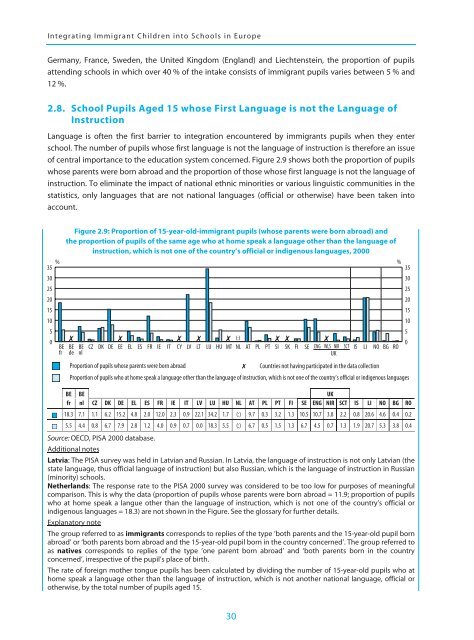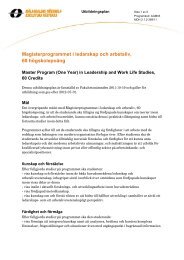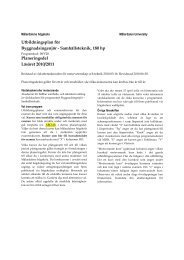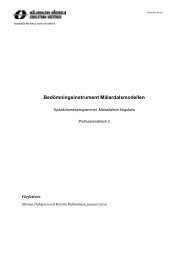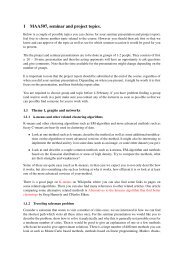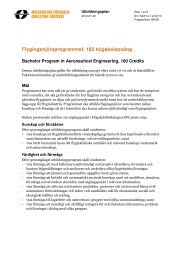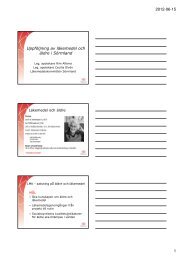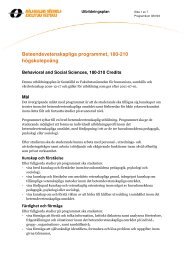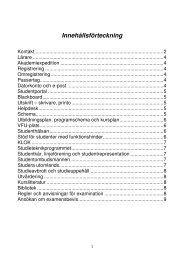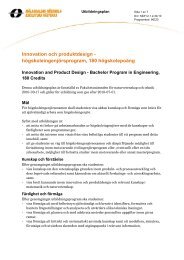Integrating Immigrant Children into Schools in Europe
Integrating Immigrant Children into Schools in Europe
Integrating Immigrant Children into Schools in Europe
Create successful ePaper yourself
Turn your PDF publications into a flip-book with our unique Google optimized e-Paper software.
<strong>Integrat<strong>in</strong>g</strong> <strong>Immigrant</strong> <strong>Children</strong> <strong><strong>in</strong>to</strong> <strong>Schools</strong> <strong>in</strong> <strong>Europe</strong>Germany, France, Sweden, the United K<strong>in</strong>gdom (England) and Liechtenste<strong>in</strong>, the proportion of pupilsattend<strong>in</strong>g schools <strong>in</strong> which over 40 % of the <strong>in</strong>take consists of immigrant pupils varies between 5 % and12 %.2.8. School Pupils Aged 15 whose First Language is not the Language ofInstructionLanguage is often the first barrier to <strong>in</strong>tegration encountered by immigrants pupils when they enterschool. The number of pupils whose first language is not the language of <strong>in</strong>struction is therefore an issueof central importance to the education system concerned. Figure 2.9 shows both the proportion of pupilswhose parents were born abroad and the proportion of those whose first language is not the language of<strong>in</strong>struction. To elim<strong>in</strong>ate the impact of national ethnic m<strong>in</strong>orities or various l<strong>in</strong>guistic communities <strong>in</strong> thestatistics, only languages that are not national languages (official or otherwise) have been taken <strong><strong>in</strong>to</strong>account.302520151050Figure 2.9: Proportion of 15-year-old-immigrant pupils (whose parents were born abroad) andthe proportion of pupils of the same age who at home speak a language other than the language of<strong>in</strong>struction, which is not one of the country’s official or <strong>in</strong>digenous languages, 2000% %3535BEfr✗ ✗ ✗ ✗ ✗ (:) ✗ ✗ ✗CZ DK DE EE EL ES FR IE IT CY LV LT LU HU MT NL AT PL PT SI SK FI SE ENG WLSBEdeBEnlProportion of pupils whose parents were born abroad Countries not hav<strong>in</strong>g participated <strong>in</strong> the data collectionNO BGProportion of pupils who at home speak a language other than the language of <strong>in</strong>struction, which is not one of the country’s official or <strong>in</strong>digenous languagesBE BE UKfr nl CZ DK DE EL ES FR IE IT LV LU HU NL AT PL PT FI SE ENG NIR SCT IS LI NO BG RO18.3 7.1 1.1 6.2 15.2 4.8 2.0 12.0 2.3 0.9 22.1 34.2 1.7 (:) 9.7 0.3 3.2 1.3 10.5 10.7 3.8 2.2 0.8 20.6 4.6 0.4 0.25.5 4.4 0.8 6.7 7.9 2.8 1.2 4.0 0.9 0.7 0.0 18.3 5.5 (:) 6.7 0.5 1.5 1.3 6.7 4.5 0.7 1.3 1.9 20.7 5.3 3.8 0.4Source: OECD, PISA 2000 database.Additional notesLatvia: The PISA survey was held <strong>in</strong> Latvian and Russian. In Latvia, the language of <strong>in</strong>struction is not only Latvian (thestate language, thus official language of <strong>in</strong>struction) but also Russian, which is the language of <strong>in</strong>struction <strong>in</strong> Russian(m<strong>in</strong>ority) schools.Netherlands: The response rate to the PISA 2000 survey was considered to be too low for purposes of mean<strong>in</strong>gfulcomparison. This is why the data (proportion of pupils whose parents were born abroad = 11.9; proportion of pupilswho at home speak a langue other than the language of <strong>in</strong>struction, which is not one of the country’s official or<strong>in</strong>digenous languages = 18.3) are not shown <strong>in</strong> the Figure. See the glossary for further details.Explanatory noteThe group referred to as immigrants corresponds to replies of the type ‘both parents and the 15-year-old pupil bornabroad’ or ‘both parents born abroad and the 15-year-old pupil born <strong>in</strong> the country concerned’. The group referred toas natives corresponds to replies of the type ‘one parent born abroad’ and ‘both parents born <strong>in</strong> the countryconcerned’, irrespective of the pupil’s place of birth.The rate of foreign mother tongue pupils has been calculated by divid<strong>in</strong>g the number of 15-year-old pupils who athome speak a language other than the language of <strong>in</strong>struction, which is not another national language, official orotherwise, by the total number of pupils aged 15.NIRUKSCTISLIRO30252015105030


